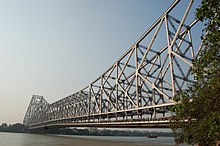Some interesting facts about Howrah Bridge, Kolkata:
1. Howrah Bridge is a cantilever bridge that spans over the Hooghly River in West Bengal. A cantilever bridge is the one built using cantilevers, structures that project horizontally into space, supported on only one end.
2. The bridge does not have nuts and bolts and was built by riveting the whole structure.
3. On June 14th, 1965, the bridge was renamed Rabindra Setu after the great Bengali poet Rabindranath Tagore. However, it is still popularly known as Howrah Bridge.
4. It carries a daily traffic of approximately 100,000 vehicles and possibly more than 150,000 pedestrians, making it one of the busiest cantilever bridges in the world.
5. At the time of its construction, it was the 3rd longest cantilever bridge. Now, it’s the sixth longest bridge of its type in the world!
6. The first vehicle to use the bridge was a solitary tram.
7. Bird droppings and human spitting cause corrosion to the bridge. The Kolkata Port Trust (KoPT ) engaged contractors to regularly clean the bird droppings, at an annual expense of Rs. 500000. The KoPT also spent Rs. 6.5 million to paint the entire bridge, which required a total of 26,500 litres of paint.
8. 26,500 tons of steel was consumed in the construction of Howrah Bridge, out of which 23,000 tons of high-tensile alloy steel, known as Tiscrom, was supplied by Tata Steel.
9. It has featured in numerous movies, Hindi, Malayalam, Bengali, Tamil, etc. Few movies shot here are Gunday, Barfi!, Love Aaj Kal, Tamil film Aadhavan, Malayalam Film Calcutta News, Roland Joffé’s English language film City of Joy and the list goes on…
Howrah Bridge is a cantilever bridge with asuspended span over the Hooghly River inWest Bengal, India. Commissioned in 1943, the bridge was originally named the New Howrah Bridge, because it replaced apontoon bridge at the same location linking the two cities of Howrah and Kolkata(Calcutta). On 14 June 1965 it was renamedRabindra Setu after the great Bengali poetRabindranath Tagore, who was the first Indian and Asian Nobel laureate. It is still popularly known as the Howrah Bridge.
The bridge is one of two on the Hooghly Riverand is a famous symbol of Kolkata and West Bengal. The other bridges are the Vidyasagar Setu (popularly called the Second Hooghly Bridge), the Vivekananda Setu, and the newly built Nivedita Setu. It weathers the storms of the Bay of Bengal region, carrying a dailytraffic of approximately 100,000 vehiclesand possibly more than 150,000 pedestrians, easily making it the busiest cantilever bridge in the world. The third-longest cantilever bridge at the time of its construction, the Howrah Bridge is currently the sixth-longest bridge of its type in the world.
History
1862 proposal by Turnbull
In 1862, the Government of Bengal asked George Turnbull, Chief Engineer of the East India Railway Company to study the feasibility of bridging the Hooghly River — he had recently established the company's rail terminus in Howrah. He reported on 29 March with large-scale drawings and estimates that:
- The foundations for a bridge at Calcutta would be at a considerable depth and cost because of the depth of the mud there.
- The impediment to shipping would be considerable.
- A good place for the bridge was at Pulta Ghat "about a dozen miles north of Calcutta" where a "bed of stiff clay existed at no great depth under the river bed".
- A suspended-girder bridge of five spans of 400 feet and two spans of 200 feet would be ideal.
The bridge was not built.
Pontoon bridge
In view of the increasing traffic across the Hooghly river, a committee was appointed in 1855-56 to review alternatives for constructing a bridge across it. The plan was shelved in 1859-60, to be revived in 1868, when it was decided that a bridge should be constructed and a newly appointed trust vested to manage it. The Calcutta Port Trustwas founded in 1870, and the Legislative department of the then Government of Bengal passed the Howrah Bridge Act in the year 1871 under the Bengal Act IX of 1871, ]empowering the Lieutenant-Governor to have the bridge constructed with Government capital under the aegis of the Port Commissioners.
Eventually a contract was signed with Sir Bradford Leslie to construct a pontoon bridge. Different parts were constructed in England and shipped to Calcutta, where they were assembled. The assembling period was fraught with problems. The bridge was considerably damaged by the great cyclone on 20 March 1874. A steamer named Egeriabroke from her moorings and collided head-on with the bridge, sinking three pontoons and damaging nearly 200 feet of the bridge. The bridge was completed in 1874, at a total cost of ₹2.2 million, and opened to traffic on 17 October of that year. The bridge was then 1528 ft. long and 62 ft. wide, with 7-foot wide pavements on either side. Initially the bridge was periodically unfastened to allow steamers and other marine vehicles to pass through. Before 1906, the bridge used to be undone for the passage of vessels during daytime only. Since June of that year it started opening at night for all vessels except ocean steamers, which were required to pass through during daytime. From 19 August 1879, the bridge was illuminated by electric lamp-posts, powered by the dynamo at the Mullick Ghat Pumping Station. As the bridge could not handle the rapidly increasing load, the Port Commissioners started planning in 1905 for a new improved bridge.
https://linksredirect.com/?pub_id=11719CL10653&subid=2&url=http%3A//www.archiesonline.com/










No comments:
Post a Comment